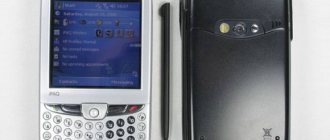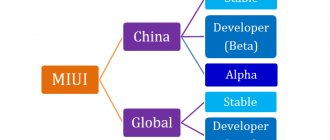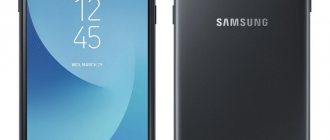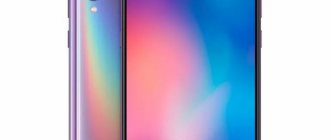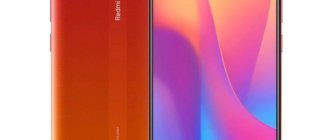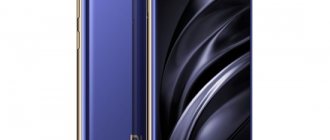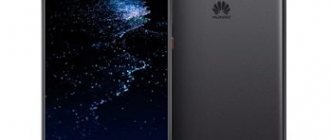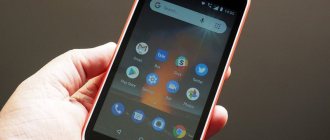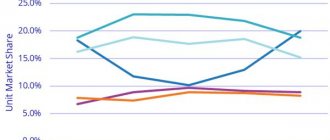Today, some users are looking on the Internet for information about what a communicator is. Some people think that it might be better to buy a communicator rather than a smartphone. Although today the difference between these devices is almost invisible.
Moreover, most companies simply stopped producing such devices. The reason for this is very simple: there are smartphones and they have all the functions the user needs. But even in 2020, many still decide to purchase a communicator, so it would be useful to consider the difference between this device and all the others and the nuances of its use.
Definition
A communicator is a pocket personal computer with built-in modules for making calls. That is, it is a PDA and a regular mobile phone. But today, many have already forgotten what a PDA is, so it makes sense to explain this concept too.
So, a PDA is a small device that allows you to work with email, office applications, listen to music and play some games. All computer tasks are performed on it, only this device is very small.
In 2008, PDAs were extremely popular, because then no one could have imagined that you could edit documents and presentations, listen to music and watch movies on a regular mobile phone. True, today it is no longer just a mobile phone, but a smartphone, that is, a “smart phone” that combines all these devices.
Previously, many people used PDAs as an e-reader. They used the Windows Mobile operating system.
Thus, a communicator is a pocket personal computer, supplemented with modules of a regular mobile phone, and a smartphone is a regular mobile phone, supplemented with modules of a pocket personal computer.
This is the most important difference between a communicator and a smartphone. Everything else flows from it. Accordingly, all office applications, movie and music players, and everything else related to computer operation work much better on communicators.
On smartphones, all this works much less productively and user-friendly. Although, again, all this was very relevant for 2008, when smartphones were something of a fantasy and only a few of them made it possible to edit documents and watch movies.
Today, any smartphone for $50 has a pre-installed set of office applications, players, even GPS modules and much more. Actually, that’s why almost everyone has already forgotten about communicators.
From all of the above, we can highlight the following features of the communicator:
- This is a pocket personal computer, supplemented with telephone functions (the opposite is true for a smartphone).
- Office applications and other programs that are found on a regular computer work better and faster on communicators.
- Communicators run on the Windows Mobile operating system, like PDAs.
Honor 8 series
If in 2020 the Honor 8 smartphone was the flagship of the brand’s lineup, now the Honor 8 family includes fairly inexpensive models. The exception is Honor 8X, which costs from 17,990 rubles. But this is a smartphone with a huge 6.5-inch screen, a glass body and quite powerful hardware.
Honor 8X review: a smartphone with a huge screen and at a crazy price
Honor 8X
The remaining models of the Honor 8 series cost noticeably less. The simplest among them is Honor 8S: it is offered for 8,490 rubles and does not even have a fingerprint scanner. Honor 8A for 9,990 is a little more serious: it has more memory, a larger screen, a fingerprint sensor, plus NFC. Next comes the strange smartphone Honor 8A Pro, which, oddly enough, no longer has NFC, but offers even more memory. It costs 13,990 rubles. With all this, there is also Honor 8C for 12,990, which has an even larger screen, a 4000 mAh battery, and a dual rear camera.
The principle of assigning letters to Honor 8 smartphones is mysterious and mysterious. The model with the letter S is weaker than the model with the letter A, and the model with Honor 8C is more interesting than Honor 8A. At the same time, Honor 8A Pro is more expensive than all the smartphones listed in this paragraph, although in some ways it is inferior even to the Honor 8A model (in particular, the lack of NFC). Honor 8X, in turn, is generally the coolest. This cannot be understood logically.
Honor 8S
The Honor 8 Max model stands out, where the word Max means the presence of a huge screen - its diagonal is comparable to a tablet and reaches 7.12 inches. The price of the model in Russia is 21,490 rubles.
Honor 8X Max
How to buy a communicator
Interestingly, today it is almost impossible to find communicators in stores. Where it says that this is a communicator, the description says that it is a smartphone. That is, for employees of websites selling equipment, these concepts are synonymous, but this is not at all true.
And in some stores there is such a product category as “smartphone/communicator”. For example, the iPhone 4 is called a communicator, although this is completely wrong. Apple's brainchild was not initially created as a PDA, it was immediately a smartphone, by the way, one of the first full-fledged smartphones in the world.
In some stores, in the “communicators” category there are generally some kind of alarm control panels, walkie-talkies and other devices that are not at all related to this topic. Yes, there are communicators that are used in GSM, Ethernet and other technologies, but these are not at all the devices we are talking about.
This shows that today very few people know what a communicator is and how it differs from a smartphone. But, as mentioned above, a communicator must be, first of all, a personal computer with telephone functions, and not vice versa. That is, initially it is a PDA. Therefore, it would be useful to consider what full-fledged communicators exist today.
What can phones from the Middle Kingdom do?
If earlier Chinese mobile phones were only replicas of companies such as Samsung and Apple, now they themselves rule the roost. The very first gadget without frames, which became popular in the world, was released by Xiaomi. It was designated as Mi Mix. Only a year later, the Cupertino team was able to release their own frameless phone. In the winter of 2020, the first phone with a fingerprint on the screen from Vivo was released. In the spring of 2020, Huawei and Leika released a smartphone for Android, which featured a triple camera that was superior in photo quality to the iPhone XS/XS Max models.
Model overview
Unitech PA820
A very durable industrial communicator that combines the functions of a classic PDA, a terminal (it has many sensors and sensors) and a smartphone. Basically, Unitech PA820 is used in industrial enterprises, construction sites, in harsh weather conditions, for example, in Antarctica and other similar places. It is quite impact resistant.
Features of Unitech PA820:
- Can be used at temperatures from -20 to +50 degrees.
- Has IP66 protection level. This means you can throw it from a height of 180 meters and it will still work as if nothing happened (tested).
- RAM - 0.5 GB (built-in is the same).
- TI AM3715 processor with a frequency of 1 GHz.
- Pre-installed Windows 6.5 OS.
- There is Wi-Fi, Bluetooth, 3.5 mm jack.
- Three batteries for 2200 mAh, 440 mAh and 4000 mAh.
HTC HD2
Here is a more familiar and familiar design to all of us, which resembles a regular smartphone. Although at the bottom there are very special 5 buttons that indicate that this is not an ordinary device. There are buttons to make a call, “home”, “Windows”, “back” and end the call. In 2010, this device created a real sensation when it appeared on the market. Although today its technical characteristics look very lackluster:
- OS Windows Mobile 6.5;
- RAM - 448 MB;
- built-in memory - 512 MB;
- 1230 mAh battery;
- single-core Qualcomm QSD8250 processor at 1 GHz;
- there is GPS, Wi-Fi, Bluetooth, USB and 3G.
It is interesting that, despite using Windows OS, this device still has the proprietary HTC Sense interface shell. By the way, HTC today is one of the few manufacturers that continue to produce full-fledged communicators. HTC Sensation, HTC Legend, HTC Wildfire S, HTC Incredible S, good old HTC Love, HTC HD Mini and much more can still be seen on store shelves today.
Garmin-ASUS Nuvifone M20
By the way, ASUS is also one of those daredevils who produce full-fledged communicators. One of the latest models (although it was released more than five years ago) is the Garmin-ASUS Nuvifone M20.
The features of this device are as follows:
- There is a unique Garmin Nuvi navigation system, which, by the way, works very well. In general, in most cases the Nuvifone M20 is used as a navigator, and not as a phone or communicator. Within this tool, there are many additional location tools available on the device.
- A simple single-core Qualcomm MSM7200 processor with a frequency of 528 MHz.
- Built-in memory is 4 GB, which is very unusual for communicators.
- The battery is 920 mAh, which is enough for only 3 hours of battery life. True, it is removable and can be easily changed.
Thus, today you can buy a communicator only if the high-quality operation of office and other similar applications, which were originally intended for a computer and then adapted for smaller devices, is important to you. Or you really like HTC products and want something special. Today, almost no one produces communicators, because everything the same is available on smartphones.
At one time, Samsung also tried to make such equipment. You can see what they came up with below.
More than a dozen years have passed since the appearance of the first mobile phone. Over time, they were constantly improved, new functions were added, and their sizes were reduced. But at one point, all the functions invented by engineers became cramped in the concept of “mobile phone.” This is how the concept of “communicator” arose, and then “smartphone”.
- A mobile phone
is a portable communication device intended primarily for voice communication. - Smartphone
(eng. smartphone - smart phone) is a mobile phone, supplemented with the functionality of a pocket personal computer. - Communicator
(eng. communicator, PDA phone) is a pocket personal computer, supplemented with the functionality of a mobile phone.
The presence of a fully functional operating system makes smartphones and communicators more attractive in the eyes of most users.
Modern solutions (mid-price models and above) cope well with many tasks that go beyond telephone calls: working with email, viewing text documents and spreadsheets, working with a task scheduler and many others. Expanding the functionality of phones is possible through J2ME programs, which are supported by almost all mobile devices. The screen of a number of phones is as good as most smartphones, and many models are equipped with a memory card slot. It is important to note that programs written specifically for the operating system of a smartphone or communicator are complete sequences of low-level microprocessor commands compiled into binary code. Specialized applications use processor resources more efficiently and, as a rule, have greater functionality than “universal” J2ME programs.
However, for most users this circumstance is not the main selection criterion. Smartphones are promoted by manufacturers due to other factors, such as:
- Advanced multimedia features (better camera, enhanced video playback capabilities, improved music capabilities);
- Increasing the number of cores and processor frequency;
- Using a unique model design;
- Protecting the device from external influences.
The history of smartphones
What is the first smartphone? They tried to combine the functionality of a mobile phone and a communicator almost immediately after the appearance of the first communicators in the early 90s of the last century.
Communicator
Communicator Qtek S100
Smartphone
, less commonly,
a smartphone
(English
smartphone
- smart phone) is a mobile phone with advanced functionality comparable to a pocket personal computer (PDA). Also, the term “communicator” is often used to refer to some devices that combine the functionality of a mobile phone and a PDA.
At the end of 2008, Nokia released the Nokia 5800 touchscreen device based on Symbian OS 9.4. The smartphone supports control without using a stylus and is aimed at the mass market. Simultaneously with this device, the flagship smartphone Nokia N97 with a touch screen and a sliding QWERTY/YZUKEN keyboard was announced.
Features of the MiPad line
It is easier to make comparisons between Xiaomi tablets - there are only three models. The Xiaomi Mi Pad was a trial version to see if the tablet would be as popular as smartphones. It turned out that everything was in perfect order, and therefore the Chinese launched Xiaomi Mi Pad 2, starting with which they firmly established themselves in this niche in the market.
The differences between the first and second models are noticeable to the naked eye. The body of the “two” is made of metal, not polycarbonate, the RAM is already 2 GB, and you can choose between Android and Windows 10 as an operating system.
Xiaomi Mi Pad 3 has gone even further - here you can already choose between two main configurations that differ in the amount of built-in and operating memory: 3 GB of RAM with 64 GB of built-in or 4 GB of RAM with 128 GB of built-in. The chipset has also been improved in comparison with the more budget “two” - instead of the Intel Atom X5-Z8500, the Intel Atom X7-Z8700 appeared.
When releasing the Xiaomi Mi Pad 4, the developers focused on the “powerful processor” Qualcomm Snapdragon 660. The updated Mi Pad 4 abandoned experiments with Windows 10 and DualBoot, continuing the traditional line of Android-based tablet computers.
The most common smartphone manufacturers
|
Smartphone market statistics by manufacturer:
| Manufacturer | 3 sq. 2007 | % | 3 sq. 2008 | % | change 3Q 08 / 3Q 07 | |
| RIM ( | HTC | 850 400 | 2,7 % | 2 308 210 | 5,8 % | 171,4 % |
| Others | 7 816 100 | 25,1 % | 6 791 530 | 17,0 % | −13,1 % | |
| All manufacturers | 31 156 240 | 100,0 % | 39 850 100 | 100 % | 27,9 % |
OS
The most common operating systems and platforms for smartphones:
Smartphone product statistics by operating system share:
| Platform | 3 sq. 2005 | % | 3 sq. 2006 | % | 3 sq. 2007 | % | 3 sq. 2008 | % | |
| Symbian OS | 8 164 790 | 59,7 % | 13 217 980 | 72,8 % | 21 219 390 | 68,1 % | 18 583 060 | 46,6 % | |
| MacOS | — | — | — | — | 1 107 460 | 3,6 % | 6 899 010 | 17,3 % | |
| RIM ( | Windows Mobile | 302 280 | 2,2 % | 1 025 540 | 5,6 % | 3 797 360 | 12,2 % | 5 425 470 | 13,6 % |
| Palm OS | 621 700 | 4,5 % | 333 340 | 1,8 % | — | — | — | — | |
| Others | 85 580 | 0,6 % | 51 308 | 0,3 % | 372 130 | 1,2 % | 862 340 | 2,2 % | |
| Total | 12 389 890 | 90,5 % | 18 164 618 | 100 % | 31 156 240 | 100 % | 39 850 100 | 100 % |
Smartphones and malware
The openness of the operating system of smartphones and communicators gives rise to another problem that is well known to users of personal computers - computer viruses and other malicious programs. To protect against this danger, most leading antivirus software developers have created special versions of antivirus programs for mobile operating systems (for example, Kaspersky Mobile Security from Kaspersky Lab).
Most modern malware for mobile devices (mostly Trojans) are distributed via the Internet under the guise of useful programs (games, codecs for video players and others), or locally in crowded places via Bluetooth from strangers, do not install suspicious programs from unreliable sources and etc. However, in the future, with the growing use of smartphones and communicators to access the Internet (thanks to the introduction of new wireless communication technologies WiMAX and others), malware for mobile devices can become a serious danger.
It should also be noted that regular mobile phones can also be infected with malware (there are malicious J2ME programs, it is possible to exploit phone OS vulnerabilities, etc.).
What do the letters in the Xiaomi model mean?
Understanding the letters is a little easier than remembering all the series or the number of device models in the Xiaomi series.
- A – for example, Redmi 5A, an index of smartphones with low performance; as a rule, models with the “A” index are the cheapest of the series;
- S, X – for example, Redmi 3S, this index is not currently used, has now been replaced by the “X” index, an improved or “fast” smartphone model;
- Pro - for example Redmi Note 5 Pro, the index means an advanced version of the smartphone, with some other hardware.
Xiaomi changes its letter or word designations every year, it won’t be possible to mark everything, but it’s still worth sticking to.
To make it easier to choose a Xiaomi smartphone, we have prepared a device rating based on ratings from the AnTuTu application.
Links
- Communicator - the history of the appearance of Mobile-Review devices
- Smartphones and communicators: from birth to the present day Mobi magazine
- Database on PDAs, smartphones and communicators (English)
| Computer dimensions | ||
| Large | ||
Articles and Lifehacks
Today the market offers a wide selection of smartphones and communicators, but a person who does not understand the intricacies of the mobile world cannot understand how one thing differs from another and which one to choose.
Some people ask: “What is a communicator on a phone?” But before answering this question, let's figure out what this thing is.
- In a telephone, the primary function is to make calls, and a communicator, or, as it is often called, a PDA, is a portable computer that has the secondary function of making calls.
- Typically, PDAs have a larger display size than smartphones. And they are controlled using a stylus - a special accessory for controlling the touch interface.
- Communicators can be divided into two groups: the first runs on the MS Windows Mobile operating system, and the second runs on Palm OS.
Honor 20 series
As of mid-2020, it is the flagship family of smartphones. At the same time, it includes not only the top-end Honor 20 and Honor 20 Pro devices, but also, for example, the relatively inexpensive Honor 20i device. In some markets it will be offered under the name Honor 20 Lite, and in Russia, oddly enough, it has long been sold under the name ... Honor 10i.
Honor 20 Pro
Comparing both devices
The PDA is equipped with a more powerful processor and more RAM than a smartphone.
These characteristics directly affect the speed and quality of work. It’s not hard to guess that the first device will have higher numbers.
But technology does not stand still, and smartphones are now equipped in such a way that they will soon no longer be inferior in performance to PDAs. Take, for example, the Samsung Galaxy S5.
It has a quad-core processor (not all computers have this) and also has a display that supports Full HD expansion.
To summarize, we can say that a smartphone is a telephone with the functions of a communicator, and a PDA is a mini-computer that has some of the properties of a telephone.
What are Xiaomi Redmi?
Xiaomi Redmi is divided into three series: simply Redmi, Redmi Note and Redmi Pro.
Redmi
Classic smartphones with a standard screen size of 5 inches. Unlike the flagship Mi, the Redmi line is more diverse. Here you will find both frankly cheap devices made of plastic and with an entry-level processor, as well as very productive mid-range devices with claims to flagship status.
Xiaomi Redmi 4
At the moment, the fourth generation of Redmi is relevant, represented by four models:
- Redmi 4 is the base model based on Snapdragon 430 with an HD screen. The body is made of metal.
- Redmi 4 Pro is the older version of Redmi 4 with a more powerful Snapdragon 625 processor, Full HD screen and increased memory.
- Redmi 4X is an intermediate option between the basic and older models based on Snapdragon 435. The processor is slightly better than that of Redmi 4, the screen is the same. Versions are available with a memory capacity identical to both the basic and older Redmi 4 models.
- Redmi 4A is an ultra-budget smartphone based on Snapdragon 425 in a polycarbonate body. The ideal entry-level smartphone.
Redmi Note
Redmi Note is a series of 5.5-inch (Full HD, IPS) Xiaomi smartphones.
Xiaomi Redmi Note 4
At the moment, the fourth generation of Redmi Note is relevant, represented by Redmi Note 4 models based on MediaTek Helio X20 and Snapdragon 625.
Redmi Pro
Redmi Pro is a series of 5.5-inch (Full HD, AMOLED) Xiaomi smartphones based on MediaTek Helio X20 and X25 with a front-mounted fingerprint sensor and a dual main camera.
Xiaomi Redmi Pro
Did this classification help you? Do you have a clear understanding of the Xiaomi smartphone lineup in your head? If not, then it's okay. There are really so many Xiaomi smartphones that it is no longer possible to organize them.
We are in no way saying that all manufacturers should follow Apple's example, that is, release one or two smartphones, telling everyone that this is how it should be. Freedom of choice is important, but everything is good in moderation.
We hope that in the near future Xiaomi will restore order and make sure that everything is clear to everyone.
And here you will find a detailed guide to Meizu smartphones.
